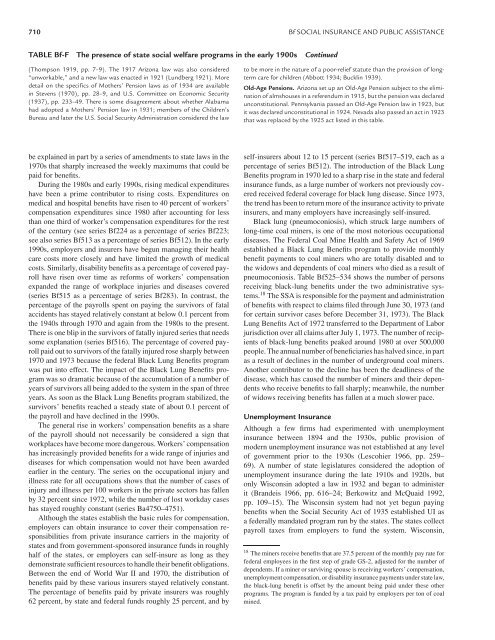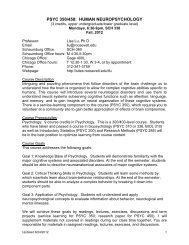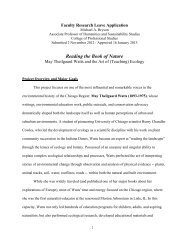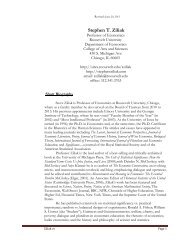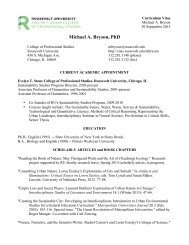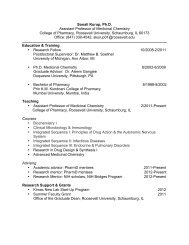Social Insurance and Public Assistance
public-assistance-welfare-reform-colonial-times-to-the-present-ziliak ...
public-assistance-welfare-reform-colonial-times-to-the-present-ziliak ...
You also want an ePaper? Increase the reach of your titles
YUMPU automatically turns print PDFs into web optimized ePapers that Google loves.
710 Bf SOCIAL INSURANCE AND PUBLIC ASSISTANCE<br />
TABLE Bf-F The presence of state social welfare programs in the early 1900s Continued<br />
(Thompson 1919, pp. 7–9). The 1917 Arizona law was also considered<br />
“unworkable,” <strong>and</strong> a new law was enacted in 1921 (Lundberg 1921). More<br />
detail on the specifics of Mothers’ Pension laws as of 1934 are available<br />
in Stevens (1970), pp. 28–9, <strong>and</strong> U.S. Committee on Economic Security<br />
(1937), pp. 233–49. There is some disagreement about whether Alabama<br />
had adopted a Mothers’ Pension law in 1931; members of the Children’s<br />
Bureau <strong>and</strong> later the U.S. <strong>Social</strong> Security Administration considered the law<br />
to be more in the nature of a poor-relief statute than the provision of longterm<br />
care for children (Abbott 1934; Bucklin 1939).<br />
Old-Age Pensions. Arizona set up an Old-Age Pension subject to the elimination<br />
of almshouses in a referendum in 1915, but the pension was declared<br />
unconstitutional. Pennsylvania passed an Old-Age Pension law in 1923, but<br />
it was declared unconstitutional in 1924. Nevada also passed an act in 1923<br />
that was replaced by the 1925 act listed in this table.<br />
be explained in part by a series of amendments to state laws in the<br />
1970s that sharply increased the weekly maximums that could be<br />
paid for benefits.<br />
During the 1980s <strong>and</strong> early 1990s, rising medical expenditures<br />
have been a prime contributor to rising costs. Expenditures on<br />
medical <strong>and</strong> hospital benefits have risen to 40 percent of workers’<br />
compensation expenditures since 1980 after accounting for less<br />
than one third of worker’s compensation expenditures for the rest<br />
of the century (see series Bf224 as a percentage of series Bf223;<br />
see also series Bf513 as a percentage of series Bf512). In the early<br />
1990s, employers <strong>and</strong> insurers have begun managing their health<br />
care costs more closely <strong>and</strong> have limited the growth of medical<br />
costs. Similarly, disability benefits as a percentage of covered payroll<br />
have risen over time as reforms of workers’ compensation<br />
exp<strong>and</strong>ed the range of workplace injuries <strong>and</strong> diseases covered<br />
(series Bf515 as a percentage of series Bf283). In contrast, the<br />
percentage of the payrolls spent on paying the survivors of fatal<br />
accidents has stayed relatively constant at below 0.1 percent from<br />
the 1940s through 1970 <strong>and</strong> again from the 1980s to the present.<br />
There is one blip in the survivors of fatally injured series that needs<br />
some explanation (series Bf516). The percentage of covered payroll<br />
paid out to survivors of the fatally injured rose sharply between<br />
1970 <strong>and</strong> 1973 because the federal Black Lung Benefits program<br />
was put into effect. The impact of the Black Lung Benefits program<br />
was so dramatic because of the accumulation of a number of<br />
years of survivors all being added to the system in the span of three<br />
years. As soon as the Black Lung Benefits program stabilized, the<br />
survivors’ benefits reached a steady state of about 0.1 percent of<br />
the payroll <strong>and</strong> have declined in the 1990s.<br />
The general rise in workers’ compensation benefits as a share<br />
of the payroll should not necessarily be considered a sign that<br />
workplaces have become more dangerous. Workers’ compensation<br />
has increasingly provided benefits for a wide range of injuries <strong>and</strong><br />
diseases for which compensation would not have been awarded<br />
earlier in the century. The series on the occupational injury <strong>and</strong><br />
illness rate for all occupations shows that the number of cases of<br />
injury <strong>and</strong> illness per 100 workers in the private sectors has fallen<br />
by 32 percent since 1972, while the number of lost workday cases<br />
has stayed roughly constant (series Ba4750–4751).<br />
Although the states establish the basic rules for compensation,<br />
employers can obtain insurance to cover their compensation responsibilities<br />
from private insurance carriers in the majority of<br />
states <strong>and</strong> from government-sponsored insurance funds in roughly<br />
half of the states, or employers can self-insure as long as they<br />
demonstrate sufficient resources to h<strong>and</strong>le their benefit obligations.<br />
Between the end of World War II <strong>and</strong> 1970, the distribution of<br />
benefits paid by these various insurers stayed relatively constant.<br />
The percentage of benefits paid by private insurers was roughly<br />
62 percent, by state <strong>and</strong> federal funds roughly 25 percent, <strong>and</strong> by<br />
self-insurers about 12 to 15 percent (series Bf517–519, each as a<br />
percentage of series Bf512). The introduction of the Black Lung<br />
Benefits program in 1970 led to a sharp rise in the state <strong>and</strong> federal<br />
insurance funds, as a large number of workers not previously covered<br />
received federal coverage for black lung disease. Since 1973,<br />
the trend has been to return more of the insurance activity to private<br />
insurers, <strong>and</strong> many employers have increasingly self-insured.<br />
Black lung (pneumoconiosis), which struck large numbers of<br />
long-time coal miners, is one of the most notorious occupational<br />
diseases. The Federal Coal Mine Health <strong>and</strong> Safety Act of 1969<br />
established a Black Lung Benefits program to provide monthly<br />
benefit payments to coal miners who are totally disabled <strong>and</strong> to<br />
the widows <strong>and</strong> dependents of coal miners who died as a result of<br />
pneumoconiosis. Table Bf525–534 shows the number of persons<br />
receiving black-lung benefits under the two administrative systems.<br />
18 The SSA is responsible for the payment <strong>and</strong> administration<br />
of benefits with respect to claims filed through June 30, 1973 (<strong>and</strong><br />
for certain survivor cases before December 31, 1973). The Black<br />
Lung Benefits Act of 1972 transferred to the Department of Labor<br />
jurisdiction over all claims after July 1, 1973. The number of recipients<br />
of black-lung benefits peaked around 1980 at over 500,000<br />
people. The annual number of beneficiaries has halved since, in part<br />
as a result of declines in the number of underground coal miners.<br />
Another contributor to the decline has been the deadliness of the<br />
disease, which has caused the number of miners <strong>and</strong> their dependents<br />
who receive benefits to fall sharply; meanwhile, the number<br />
of widows receiving benefits has fallen at a much slower pace.<br />
Unemployment <strong>Insurance</strong><br />
Although a few firms had experimented with unemployment<br />
insurance between 1894 <strong>and</strong> the 1930s, public provision of<br />
modern unemployment insurance was not established at any level<br />
of government prior to the 1930s (Lescohier 1966, pp. 259–<br />
69). A number of state legislatures considered the adoption of<br />
unemployment insurance during the late 1910s <strong>and</strong> 1920s, but<br />
only Wisconsin adopted a law in 1932 <strong>and</strong> began to administer<br />
it (Br<strong>and</strong>eis 1966, pp. 616–24; Berkowitz <strong>and</strong> McQuaid 1992,<br />
pp. 109–15). The Wisconsin system had not yet begun paying<br />
benefits when the <strong>Social</strong> Security Act of 1935 established UI as<br />
a federally m<strong>and</strong>ated program run by the states. The states collect<br />
payroll taxes from employers to fund the system. Wisconsin,<br />
18 The miners receive benefits that are 37.5 percent of the monthly pay rate for<br />
federal employees in the first step of grade GS-2, adjusted for the number of<br />
dependents. If a miner or surviving spouse is receiving workers’ compensation,<br />
unemployment compensation, or disability insurance payments under state law,<br />
the black-lung benefit is offset by the amount being paid under these other<br />
programs. The program is funded by a tax paid by employers per ton of coal<br />
mined.


